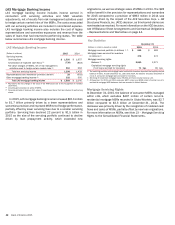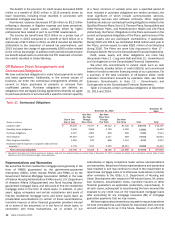Bank of America 2015 Annual Report Download - page 54
Download and view the complete annual report
Please find page 54 of the 2015 Bank of America annual report below. You can navigate through the pages in the report by either clicking on the pages listed below, or by using the keyword search tool below to find specific information within the annual report.
52 Bank of America 2015
effected through open market purchases or privately negotiated
transactions, including repurchase plans that satisfy the
conditions of Rule 10b5-1 of the Securities Exchange Act of 1934.
Regulatory Capital
As a financial services holding company, we are subject to
regulatory capital rules issued by U.S. banking regulators. On
January 1, 2014, we became subject to Basel 3, which includes
certain transition provisions through January 1, 2019. The
Corporation and its primary affiliated banking entity, BANA, are
Advanced approaches institutions under Basel 3.
Basel 3 Overview
Basel 3 updated the composition of capital and established a
Common equity tier 1 capital ratio. Common equity tier 1 capital
primarily includes common stock, retained earnings and
accumulated OCI. Basel 3 revised minimum capital ratios and
buffer requirements, added a SLR, and addressed the adequately
capitalized minimum requirements under the PCA framework.
Finally, Basel 3 established two methods of calculating risk-
weighted assets, the Standardized approach and the Advanced
approaches. For additional information, see Capital Management
– Standardized Approach and Capital Management – Advanced
Approaches on page 53.
As an Advanced approaches institution, under Basel 3, we were
required to complete a qualification period (parallel run) to
demonstrate compliance with the Basel 3 Advanced approaches
to the satisfaction of U.S. banking regulators. We received approval
to begin using the Advanced approaches capital framework to
determine risk-based capital requirements in the fourth quarter of
2015. As previously disclosed, with the approval to exit parallel
run, U.S. banking regulators requested modifications to certain
internal analytical models including the wholesale (e.g.,
commercial) credit models. All requested modifications were
incorporated, which increased our risk-weighted assets, and are
reflected in the risk-based ratios in the fourth quarter of 2015.
Having exited parallel run on October 1, 2015, we are required to
report regulatory risk-based capital ratios and risk-weighted assets
under both the Standardized and Advanced approaches. The
approach that yields the lower ratio is used to assess capital
adequacy including under the PCA framework, and was the
Advanced approaches in the fourth quarter of 2015. Prior to the
fourth quarter of 2015, we were required to report our capital
adequacy under the Standardized approach only.
Regulatory Capital Composition
Basel 3 requires certain deductions from and adjustments to
capital, which are primarily those related to MSRs, deferred tax
assets and defined benefit pension assets. Also, any assets that
are a direct deduction from the computation of capital are excluded
from risk-weighted assets and adjusted average total assets.
Basel 3 also provides for the inclusion in capital of net unrealized
gains and losses on AFS debt and certain marketable equity
securities recorded in accumulated OCI. These changes are
impacted by, among other factors, fluctuations in interest rates,
earnings performance and corporate actions. Under Basel 3
regulatory capital transition provisions, changes to the
composition of regulatory capital are generally recognized in 20
percent annual increments, and will be fully recognized as of
January 1, 2018.
Table 12 summarizes how certain regulatory capital deductions
and adjustments have been or will be transitioned from 2014
through 2018 for Common equity tier 1 and Tier 1 capital.
Table 12 Summary of Certain Basel 3 Regulatory Capital Transition Provisions
Beginning on January 1 of each year 2014 2015 2016 2017 2018
Common equity tier 1 capital
Percent of total amount deducted from Common equity tier 1 capital includes: 20% 40% 60% 80% 100%
Deferred tax assets arising from net operating loss and tax credit carryforwards; intangibles, other than mortgage servicing rights and goodwill; defined benefit pension
fund net assets; net unrealized cumulative gains (losses) related to changes in own credit risk on liabilities, including derivatives, measured at fair value; direct and
indirect investments in our own Common equity tier 1 capital instruments; certain amounts exceeding the threshold by 10 percent individually and 15 percent in
aggregate
Percent of total amount used to adjust Common equity tier 1 capital includes (1): 80% 60% 40% 20% 0%
Net unrealized gains (losses) on AFS debt and certain marketable equity securities recorded in accumulated OCI; employee benefit plan adjustments recorded in
accumulated OCI
Tier 1 capital
Percent of total amount deducted from Tier 1 capital includes: 80% 60% 40% 20% 0%
Deferred tax assets arising from net operating loss and tax credit carryforwards; defined benefit pension fund net assets; net unrealized cumulative gains (losses)
related to changes in own credit risk on liabilities, including derivatives, measured at fair value
(1) Represents the phase-out percentage of the exclusion by year (e.g., 40 percent of net unrealized gains (losses) on AFS debt and certain marketable equity securities recorded in accumulated OCI
was included in 2015).
Additionally, Basel 3 revised the regulatory capital treatment
for Trust Securities, requiring them to be transitioned from Tier 1
capital into Tier 2 capital in 2014 and 2015, until fully excluded
from Tier 1 capital in 2016, and transitioned from Tier 2 capital
beginning in 2016 with the full exclusion in 2022. As of
December 31, 2015, our qualifying Trust Securities were $1.4
billion, approximately nine bps of the Tier 1 capital ratio.
Minimum Capital Requirements
Minimum capital requirements and related buffers are being
phased in from January 1, 2014 through January 1, 2019. Effective
January 1, 2015, the PCA framework was also amended to reflect
the requirements of Basel 3. The PCA framework establishes
categories of capitalization, including “well capitalized,” based on
regulatory ratio requirements. U.S. banking regulators are required
to take certain mandatory actions depending on the category of
capitalization, with no mandatory actions required for “well-
capitalized” banking organizations, which included BANA at
























